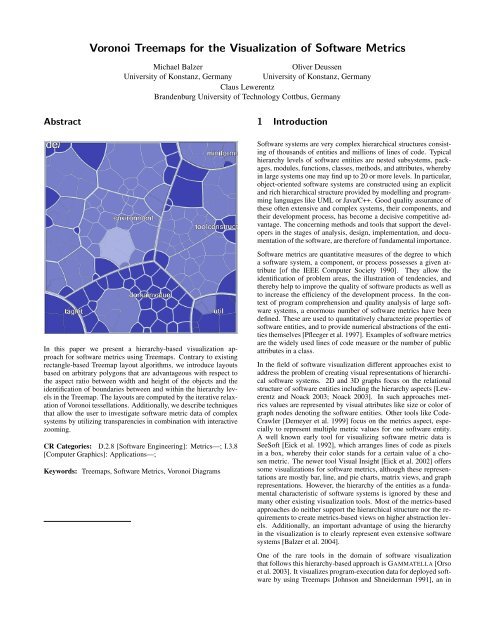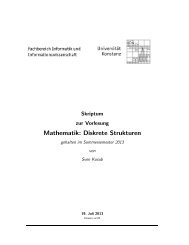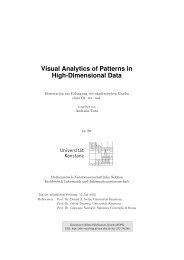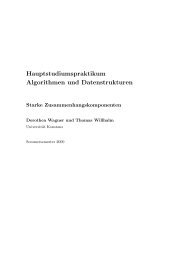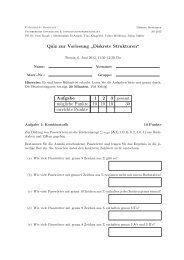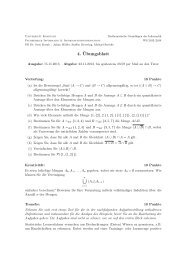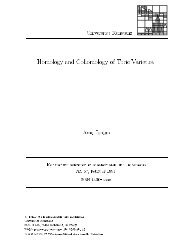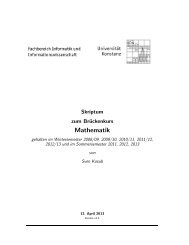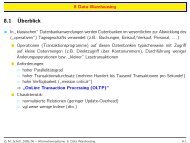Voronoi Treemaps for the Visualization of Software Metrics
Voronoi Treemaps for the Visualization of Software Metrics
Voronoi Treemaps for the Visualization of Software Metrics
You also want an ePaper? Increase the reach of your titles
YUMPU automatically turns print PDFs into web optimized ePapers that Google loves.
<strong>Voronoi</strong> <strong>Treemaps</strong> <strong>for</strong> <strong>the</strong> <strong>Visualization</strong> <strong>of</strong> S<strong>of</strong>tware <strong>Metrics</strong><br />
Michael Balzer<br />
University <strong>of</strong> Konstanz, Germany<br />
Oliver Deussen<br />
University <strong>of</strong> Konstanz, Germany<br />
Claus Lewerentz<br />
Brandenburg University <strong>of</strong> Technology Cottbus, Germany<br />
Abstract<br />
1 Introduction<br />
S<strong>of</strong>tware systems are very complex hierarchical structures consisting<br />
<strong>of</strong> thousands <strong>of</strong> entities and millions <strong>of</strong> lines <strong>of</strong> code. Typical<br />
hierarchy levels <strong>of</strong> s<strong>of</strong>tware entities are nested subsystems, packages,<br />
modules, functions, classes, methods, and attributes, whereby<br />
in large systems one may find up to 20 or more levels. In particular,<br />
object-oriented s<strong>of</strong>tware systems are constructed using an explicit<br />
and rich hierarchical structure provided by modelling and programming<br />
languages like UML or Java/C++. Good quality assurance <strong>of</strong><br />
<strong>the</strong>se <strong>of</strong>ten extensive and complex systems, <strong>the</strong>ir components, and<br />
<strong>the</strong>ir development process, has become a decisive competitive advantage.<br />
The concerning methods and tools that support <strong>the</strong> developers<br />
in <strong>the</strong> stages <strong>of</strong> analysis, design, implementation, and documentation<br />
<strong>of</strong> <strong>the</strong> s<strong>of</strong>tware, are <strong>the</strong>re<strong>for</strong>e <strong>of</strong> fundamental importance.<br />
In this paper we present a hierarchy-based visualization approach<br />
<strong>for</strong> s<strong>of</strong>tware metrics using <strong>Treemaps</strong>. Contrary to existing<br />
rectangle-based Treemap layout algorithms, we introduce layouts<br />
based on arbitrary polygons that are advantageous with respect to<br />
<strong>the</strong> aspect ratio between width and height <strong>of</strong> <strong>the</strong> objects and <strong>the</strong><br />
identification <strong>of</strong> boundaries between and within <strong>the</strong> hierarchy levels<br />
in <strong>the</strong> Treemap. The layouts are computed by <strong>the</strong> iterative relaxation<br />
<strong>of</strong> <strong>Voronoi</strong> tessellations. Additionally, we describe techniques<br />
that allow <strong>the</strong> user to investigate s<strong>of</strong>tware metric data <strong>of</strong> complex<br />
systems by utilizing transparencies in combination with interactive<br />
zooming.<br />
CR Categories: D.2.8 [S<strong>of</strong>tware Engineering]: <strong>Metrics</strong>—; I.3.8<br />
[Computer Graphics]: Applications—;<br />
Keywords: <strong>Treemaps</strong>, S<strong>of</strong>tware <strong>Metrics</strong>, <strong>Voronoi</strong> Diagrams<br />
S<strong>of</strong>tware metrics are quantitative measures <strong>of</strong> <strong>the</strong> degree to which<br />
a s<strong>of</strong>tware system, a component, or process possesses a given attribute<br />
[<strong>of</strong> <strong>the</strong> IEEE Computer Society 1990]. They allow <strong>the</strong><br />
identification <strong>of</strong> problem areas, <strong>the</strong> illustration <strong>of</strong> tendencies, and<br />
<strong>the</strong>reby help to improve <strong>the</strong> quality <strong>of</strong> s<strong>of</strong>tware products as well as<br />
to increase <strong>the</strong> efficiency <strong>of</strong> <strong>the</strong> development process. In <strong>the</strong> context<br />
<strong>of</strong> program comprehension and quality analysis <strong>of</strong> large s<strong>of</strong>tware<br />
systems, a enormous number <strong>of</strong> s<strong>of</strong>tware metrics have been<br />
defined. These are used to quantitatively characterize properties <strong>of</strong><br />
s<strong>of</strong>tware entities, and to provide numerical abstractions <strong>of</strong> <strong>the</strong> entities<br />
<strong>the</strong>mselves [Pfleeger et al. 1997]. Examples <strong>of</strong> s<strong>of</strong>tware metrics<br />
are <strong>the</strong> widely used lines <strong>of</strong> code measure or <strong>the</strong> number <strong>of</strong> public<br />
attributes in a class.<br />
In <strong>the</strong> field <strong>of</strong> s<strong>of</strong>tware visualization different approaches exist to<br />
address <strong>the</strong> problem <strong>of</strong> creating visual representations <strong>of</strong> hierarchical<br />
s<strong>of</strong>tware systems. 2D and 3D graphs focus on <strong>the</strong> relational<br />
structure <strong>of</strong> s<strong>of</strong>tware entities including <strong>the</strong> hierarchy aspects [Lewerentz<br />
and Noack 2003; Noack 2003]. In such approaches metrics<br />
values are represented by visual attributes like size or color <strong>of</strong><br />
graph nodes denoting <strong>the</strong> s<strong>of</strong>tware entities. O<strong>the</strong>r tools like Code-<br />
Crawler [Demeyer et al. 1999] focus on <strong>the</strong> metrics aspect, especially<br />
to represent multiple metric values <strong>for</strong> one s<strong>of</strong>tware entity.<br />
A well known early tool <strong>for</strong> visualizing s<strong>of</strong>tware metric data is<br />
SeeS<strong>of</strong>t [Eick et al. 1992], which arranges lines <strong>of</strong> code as pixels<br />
in a box, whereby <strong>the</strong>ir color stands <strong>for</strong> a certain value <strong>of</strong> a chosen<br />
metric. The newer tool Visual Insight [Eick et al. 2002] <strong>of</strong>fers<br />
some visualizations <strong>for</strong> s<strong>of</strong>tware metrics, although <strong>the</strong>se representations<br />
are mostly bar, line, and pie charts, matrix views, and graph<br />
representations. However, <strong>the</strong> hierarchy <strong>of</strong> <strong>the</strong> entities as a fundamental<br />
characteristic <strong>of</strong> s<strong>of</strong>tware systems is ignored by <strong>the</strong>se and<br />
many o<strong>the</strong>r existing visualization tools. Most <strong>of</strong> <strong>the</strong> metrics-based<br />
approaches do nei<strong>the</strong>r support <strong>the</strong> hierarchical structure nor <strong>the</strong> requirements<br />
to create metrics-based views on higher abstraction levels.<br />
Additionally, an important advantage <strong>of</strong> using <strong>the</strong> hierarchy<br />
in <strong>the</strong> visualization is to clearly represent even extensive s<strong>of</strong>tware<br />
systems [Balzer et al. 2004].<br />
One <strong>of</strong> <strong>the</strong> rare tools in <strong>the</strong> domain <strong>of</strong> s<strong>of</strong>tware visualization<br />
that follows this hierarchy-based approach is GAMMATELLA [Orso<br />
et al. 2003]. It visualizes program-execution data <strong>for</strong> deployed s<strong>of</strong>tware<br />
by using <strong>Treemaps</strong> [Johnson and Shneiderman 1991], an in
<strong>the</strong> in<strong>for</strong>mation visualization community well-known and popular<br />
approach <strong>for</strong> hierarchical data. Here a given area is recursively<br />
subdivided by a given hierarchy without producing holes or overlappings.<br />
The existing layout algorithms <strong>for</strong> <strong>Treemaps</strong> are solely<br />
restricted to rectangular subdivisions, which however are disadvantageous<br />
with respect to <strong>the</strong> aspect ratio between width and height <strong>of</strong><br />
<strong>the</strong> objects and <strong>the</strong> identification <strong>of</strong> boundaries between and within<br />
<strong>the</strong> hierarchy levels.<br />
In this paper we present a method allowing us to generate <strong>Treemaps</strong><br />
consisting <strong>of</strong> arbitrary polygons that enable a meaningful visualization<br />
<strong>of</strong> s<strong>of</strong>tware metrics based on <strong>the</strong> hierarchy <strong>of</strong> a s<strong>of</strong>tware<br />
system. In <strong>the</strong> following section we address <strong>the</strong> data and <strong>the</strong> characteristics<br />
<strong>of</strong> <strong>the</strong> visualized s<strong>of</strong>tware metrics. In Section 3 previous<br />
work on <strong>Treemaps</strong> is outlined. Our approach <strong>of</strong> <strong>Voronoi</strong> <strong>Treemaps</strong><br />
is presented in Section 4. Section 5 deals with assisting <strong>the</strong> user<br />
in <strong>the</strong> exploration <strong>of</strong> <strong>the</strong> data in <strong>the</strong> <strong>Treemaps</strong>. Section 6 summarizes<br />
our approach and discusses our future work. Examples <strong>of</strong> our<br />
<strong>Voronoi</strong> Treemap visualizations <strong>of</strong> s<strong>of</strong>tware metrics are shown in<br />
Section 7.<br />
2 Underlying Data<br />
3 Previous Work on <strong>Treemaps</strong><br />
<strong>Treemaps</strong> were introduced by Shneiderman and Johnson in<br />
1991 [Johnson and Shneiderman 1991]. Originally designed to visualize<br />
files on a hard drive, <strong>Treemaps</strong> have been applied to a wide<br />
variety <strong>of</strong> domains ranging from financial analysis [Jungmeister and<br />
Turo 1992; Wattenberg 1998] to sports reporting [Jin and Banks<br />
1997]. The basic idea is to subdivide a given area without producing<br />
holes or overlappings. There<strong>for</strong>e <strong>the</strong> area is alternately divided horizontally<br />
and vertically according to <strong>the</strong> hierarchy <strong>of</strong> <strong>the</strong> objects and<br />
<strong>the</strong> given proportion between <strong>the</strong> considered objects. Figure 2 illustrates<br />
this method with a simple example. Each node has a name<br />
and an associated size. The Treemap is constructed via recursive<br />
subdivision <strong>of</strong> <strong>the</strong> initial rectangle. The size <strong>of</strong> each sub-rectangle<br />
corresponds to <strong>the</strong> size <strong>of</strong> <strong>the</strong> node. The direction <strong>of</strong> <strong>the</strong> subdivision<br />
alternates per level: first horizontally, next vertically, again<br />
horizontally, etc. The initial rectangle is partitioned into smaller<br />
rectangles, so that <strong>the</strong> size <strong>of</strong> each rectangle reflects <strong>the</strong> size <strong>of</strong> <strong>the</strong><br />
leaf. As a result <strong>of</strong> its construction, <strong>the</strong> Treemap reflects <strong>the</strong> structure<br />
<strong>of</strong> <strong>the</strong> tree. This original Treemap layout algorithm is called<br />
Slice-and-Dice.<br />
Our structural models <strong>of</strong> object-oriented s<strong>of</strong>tware distinguish five<br />
types <strong>of</strong> s<strong>of</strong>tware entities: packages, classes, methods, attributes,<br />
and files. Each package can contain o<strong>the</strong>r packages, classes, and<br />
files. Each class can contain o<strong>the</strong>r classes, methods, and attributes.<br />
The schema <strong>of</strong> <strong>the</strong> models is shown in Figure 1.<br />
Figure 2: Tree diagram and corresponding Treemap<br />
Figure 1: Schema <strong>for</strong> hierarchical models <strong>of</strong> object-oriented s<strong>of</strong>tware<br />
systems<br />
Such models can be automatically extracted from <strong>the</strong> source code<br />
<strong>of</strong> object-oriented s<strong>of</strong>tware systems. In our experiments we used<br />
<strong>the</strong> tool Sotograph [S<strong>of</strong>tware-Tomography GmbH ] to extract <strong>the</strong><br />
models from Java programs. The extracted models are stored in<br />
files in Rigi Standard Format [Wong 1998]. Through <strong>the</strong> separation<br />
<strong>of</strong> extraction from visualization, and <strong>the</strong> use <strong>of</strong> a standard exchange<br />
<strong>for</strong>mat, it is possible to visualize data from many sources. In particular,<br />
<strong>the</strong>y can be applied to s<strong>of</strong>tware in any programming language<br />
<strong>for</strong> which an appropriate extractor is available.<br />
After extracting <strong>the</strong> models we possess a number <strong>of</strong> different s<strong>of</strong>tware<br />
metrics <strong>for</strong> <strong>the</strong> different entity types. They range from <strong>the</strong><br />
indication <strong>of</strong> size <strong>of</strong> <strong>the</strong> entities over <strong>the</strong> use by o<strong>the</strong>r entities, to<br />
cyclic dependencies, and many more. All <strong>of</strong> <strong>the</strong>m are quantitative<br />
measures, which means that <strong>the</strong>y can be counted, compared,<br />
ordered, and summated. To represent <strong>the</strong>se s<strong>of</strong>tware metrics with<br />
<strong>Treemaps</strong>, <strong>the</strong>y are aggregated upward in <strong>the</strong> hierarchy. For example,<br />
a class consists <strong>of</strong> several methods. All methods have a given<br />
metric value that illustrates <strong>the</strong> number <strong>of</strong> calls <strong>of</strong> this method, and<br />
<strong>the</strong> sum <strong>of</strong> calls <strong>of</strong> all contained methods is assigned to <strong>the</strong> class.<br />
Likewise <strong>the</strong>se metric values are propagated to <strong>the</strong> package level.<br />
Thereby <strong>the</strong> user is able to identify <strong>the</strong> packages and classes with<br />
frequently used methods immediately on a package or class level<br />
without having to examine <strong>the</strong> methods directly.<br />
A negative effect in <strong>the</strong>se layouts is however, that <strong>the</strong> subdivision<br />
in each step is solely done in one dimension. As result, thin elongated<br />
rectangles with a high aspect ratio between width and height<br />
emerge, if many objects or objects with high diversity in size are<br />
considered. Such long rectangles are difficult to see, select, compare<br />
in size, and label [Turo and Johnson 1992; Bruls et al. 2000].<br />
Figure 3 presents an example.<br />
This issue is addressed by Ordered <strong>Treemaps</strong> [Shneiderman and<br />
Wattenberg 2001], Squarified <strong>Treemaps</strong> [Bruls et al. 2000], Clustered<br />
<strong>Treemaps</strong> [Wattenberg 1999], and some o<strong>the</strong>r layout algorithms.<br />
These layouts subdivide <strong>the</strong> area <strong>of</strong> <strong>the</strong> initial rectangle in<br />
one step by both dimensions, meaning horizontally and vertically at<br />
<strong>the</strong> same time. The main optimization criterion <strong>of</strong> <strong>the</strong>se layout algorithms<br />
is <strong>the</strong> approximation <strong>of</strong> <strong>the</strong> sub-rectangles to <strong>the</strong> shape <strong>of</strong> a<br />
square, whereby <strong>the</strong> aspect ratio between width and height <strong>of</strong> each<br />
rectangle converges to one. Aside from <strong>the</strong> aspect ratio criterion,<br />
o<strong>the</strong>r criteria are considered as well. For example <strong>the</strong> order <strong>of</strong> <strong>the</strong><br />
objects or <strong>the</strong> nearness to a given point in <strong>the</strong> initial area, whereby<br />
<strong>the</strong> o<strong>the</strong>r criteria are <strong>of</strong>ten closely related to <strong>the</strong> respective application<br />
domain. A demonstrative member <strong>of</strong> this group <strong>of</strong> advanced<br />
Treemap layout algorithms is presented in Figure 4, showing <strong>the</strong><br />
same data set as in Figure 3 with a Squarified Treemap layout that<br />
is currently <strong>the</strong> favored layout algorithm <strong>for</strong> <strong>Treemaps</strong>.<br />
Ano<strong>the</strong>r problem in this group <strong>of</strong> algorithms is illustrated in Figure<br />
4: it is hard to differentiate if two neighbor objects are siblings<br />
or far away in <strong>the</strong> hierarchy. The problem is provoked by<br />
<strong>the</strong> square-like shape <strong>of</strong> <strong>the</strong> rectangles, and because <strong>the</strong> edges are<br />
only horizontally and vertically aligned, whereby <strong>the</strong> edges <strong>of</strong> <strong>the</strong><br />
different objects appear to run into each o<strong>the</strong>r. This effect may be<br />
reduced, but can not be prevented by using borders and/or Cushion<br />
<strong>Treemaps</strong> [van Wijk and van de Wetering 1999]. A solution <strong>for</strong><br />
this problem is <strong>the</strong> layout <strong>of</strong> <strong>Treemaps</strong> based on non-rectangular
Figure 3:<br />
<strong>Treemaps</strong><br />
Aspect ratio problem <strong>of</strong> <strong>the</strong> original Slice-and-Dice<br />
Figure 4:<br />
<strong>Treemaps</strong><br />
Hierarchy level seperation problem <strong>of</strong> Squarified<br />
objects. At this time such an approach does not exist, except in ET-<br />
Maps [Roussinov and Chen 1998] where only composite shapes <strong>of</strong><br />
rectangles are assembled. So far all Treemap layouts are restricted<br />
to axis-aligned rectangular shapes. Hence, we present our approach<br />
<strong>for</strong> polygon-based <strong>Treemaps</strong> in <strong>the</strong> next section, in which <strong>Treemaps</strong><br />
with non-regulars shapes are generated.<br />
4 <strong>Voronoi</strong> <strong>Treemaps</strong><br />
What are <strong>the</strong> constraints and optimization criteria <strong>for</strong> <strong>the</strong> shape<br />
<strong>of</strong> Treemap objects? Firstly, <strong>the</strong> distribution <strong>of</strong> <strong>the</strong> objects must<br />
fully utilize <strong>the</strong> given area, by avoiding holes and overlappings.<br />
Secondly, <strong>the</strong> objects should distinguish <strong>the</strong>mselves, meaning <strong>the</strong>y<br />
should have irregular shapes and <strong>the</strong> edges <strong>of</strong> <strong>the</strong> different objects<br />
should not run into each o<strong>the</strong>r. Thirdly, <strong>the</strong> objects should be compact,<br />
which means that <strong>the</strong> aspect ratio between <strong>the</strong>ir width and<br />
height should converge to one.<br />
Obviously polygons can be used. A polygon is defined as a closed<br />
plane figure with n sides. Special cases <strong>of</strong> polygons are triangles<br />
with n = 3, rectangles, squares, or quadrilaterals with n = 4, pentagons<br />
with n = 5, and so on. Every polygon can be divided into<br />
smaller polygons, hereby satisfying <strong>the</strong> first constraint. Polygons<br />
can have arbitrary shapes and polygons with many edges can approximate<br />
curves, which refers to <strong>the</strong> second and third optimization<br />
criterion.<br />
The principle structure <strong>of</strong> our layout algorithm is similar to <strong>the</strong> original<br />
Treemap layout algorithm. The first step is to consider <strong>the</strong> objects<br />
<strong>of</strong> <strong>the</strong> top level in <strong>the</strong> hierarchy. These objects are distributed<br />
in <strong>the</strong> given area – mostly a rectangle, but o<strong>the</strong>r shapes are possible,<br />
too. The output is a set <strong>of</strong> polygons. For <strong>the</strong> next hierarchy<br />
level, this algorithm is per<strong>for</strong>med recursively within <strong>the</strong> according<br />
polygons <strong>of</strong> <strong>the</strong> considered objects in <strong>the</strong> hierarchy, and so on.<br />
We now need a layout method, that allows us to divide a given area<br />
into polygons under consideration <strong>of</strong> <strong>the</strong> given optimization criteria.<br />
The basic idea is to use <strong>Voronoi</strong> tessellations. With <strong>the</strong>ir help,<br />
we are able to per<strong>for</strong>m an iterative relaxation <strong>of</strong> a specified number<br />
<strong>of</strong> objects with corresponding sizes in a given polygonal area.<br />
This method and <strong>the</strong> underlying <strong>the</strong>ory <strong>of</strong> <strong>Voronoi</strong> tessellations is<br />
explained in Section 4.1. However, here <strong>the</strong> problem is that <strong>for</strong><br />
<strong>the</strong> advanced <strong>Voronoi</strong> metric used by us, it is non-trivial to compute<br />
<strong>the</strong> <strong>Voronoi</strong> tessellation analytically. For our application it is<br />
quiet sufficient to compute an approximation on a numerical basis.<br />
As a consequence <strong>the</strong>re<strong>of</strong> we must extract polygons out <strong>of</strong> this numerical<br />
computed <strong>Voronoi</strong> tessellations. This step is explained in<br />
Section 4.2. We need <strong>the</strong>se polygons especially to per<strong>for</strong>m <strong>the</strong> layout<br />
in <strong>the</strong> next lower hierarchy level recursively and to display <strong>the</strong><br />
Treemap in general.<br />
4.1 Centroidal <strong>Voronoi</strong> Tessellation<br />
Let P := {p 1 ,...., p n } be a set <strong>of</strong> n distinct points, where 2 < n < ∞,<br />
in R 2 with <strong>the</strong> coordinates (x p1 ,y p1 ),...,(x pn ,y pn ). These points are<br />
<strong>the</strong> <strong>Voronoi</strong> sites. According to [de Berg et al. 2000; Okabe et al.<br />
1992], we define <strong>the</strong> <strong>Voronoi</strong> tessellation <strong>of</strong> P as <strong>the</strong> subdivision<br />
<strong>of</strong> R 2 into n cells, one <strong>for</strong> each site in P, with <strong>the</strong> property that<br />
a point q lies in <strong>the</strong> cell corresponding to a site p i if and only if<br />
distance(p i ,q) < distance(p j ,q) <strong>for</strong> each p i , p j ∈ P with i ≠ j. The<br />
denotation distance(p,q) represents a specified distance function<br />
between <strong>the</strong> two points p and q – mostly <strong>the</strong> Euclidian metric is<br />
used, which is defined as<br />
√<br />
distance(p,q) := (x p − x q ) 2 + (y p − y q ) 2 ,<br />
but o<strong>the</strong>rs such as <strong>the</strong> Manhattan metric or <strong>the</strong> Maximum metric,<br />
are possible as well. All points <strong>of</strong> a cell <strong>for</strong>m a <strong>Voronoi</strong> polygon.<br />
A Centroidal <strong>Voronoi</strong> Tessellation (CVT) [Du et al. 1999] is a<br />
<strong>Voronoi</strong> tessellation <strong>of</strong> a given set, whereby <strong>the</strong> associated generating<br />
points are centroids (centers <strong>of</strong> mass) <strong>of</strong> <strong>the</strong> corresponding<br />
<strong>Voronoi</strong> polygons. These tessellations represent arrangements similar<br />
to Poisson disc distributions. The CVT is computed by determining<br />
<strong>the</strong> <strong>Voronoi</strong> tessellation <strong>of</strong> a given point set, <strong>the</strong>n each point<br />
is moved into <strong>the</strong> mass center <strong>of</strong> its assigned <strong>Voronoi</strong> polygon, and<br />
<strong>the</strong>se two steps are repeated iteratively until <strong>the</strong> error between all<br />
point positions and <strong>the</strong> mass centers <strong>of</strong> <strong>the</strong>ir <strong>Voronoi</strong> polygons is<br />
below a given ε. Figure 5 shows an example <strong>of</strong> a <strong>Voronoi</strong> tessellation<br />
<strong>of</strong> 20 random points on <strong>the</strong> left, and <strong>the</strong> associated CVT on<br />
<strong>the</strong> right – traces illustrate <strong>the</strong> movements <strong>of</strong> <strong>the</strong> points during <strong>the</strong><br />
computation <strong>of</strong> <strong>the</strong> CVT.
To fur<strong>the</strong>r clarify <strong>the</strong> above procedure it should be noted, that firstly,<br />
<strong>the</strong> radius <strong>of</strong> a circle may have values below zero – <strong>for</strong>mally this object<br />
is not a circle, but in our application this abstraction is useful<br />
and even essential. Secondly, beside <strong>the</strong> mentioned simple adjustment<br />
<strong>of</strong> <strong>the</strong> radius according to <strong>the</strong> area size error, it is necessary<br />
to observe certain cases where <strong>the</strong> radius is or is nearby zero, and<br />
where <strong>the</strong> radius needs to be switched from positive to negative, or<br />
vice versa, to obtain better approximations.<br />
Figure 5: <strong>Voronoi</strong> tessellation <strong>of</strong> 20 random points and <strong>the</strong> associated<br />
CVT (traces illustrate <strong>the</strong> point movements during <strong>the</strong> computation<br />
<strong>of</strong> <strong>the</strong> CVT)<br />
With this basic CVT we are able to compute Treemap layouts in<br />
which every leaf node in <strong>the</strong> hierarchy has <strong>the</strong> same value. However,<br />
it is our goal to generate layouts in which <strong>the</strong> objects can have<br />
different values. Hence we need to extend <strong>the</strong> distance metric by<br />
adding a size parameter to every point. This corresponds to <strong>the</strong><br />
computation <strong>of</strong> <strong>Voronoi</strong> tessellations with circles as generator objects,<br />
where <strong>the</strong> size parameter is <strong>the</strong> radius. The resulting distance<br />
measure function is defined between a point q and a circle c with<br />
<strong>the</strong> center p and <strong>the</strong> radius r as<br />
distance(c,q) Circle := distance(p,q) − r.<br />
Additionally, <strong>the</strong> radii <strong>of</strong> <strong>the</strong> circles are not specified by precise<br />
values, but ra<strong>the</strong>r exist only as relations between all considered circles.<br />
Their absolute radii result adaptively from <strong>the</strong> momentary positions<br />
<strong>of</strong> <strong>the</strong> circles. This step is necessary because overlapping<br />
circles would o<strong>the</strong>rwise generate uncontinuous <strong>Voronoi</strong> polygons.<br />
There<strong>for</strong>e a maximum factor m is determined, so that no two circles<br />
c 1 (p 1 ,r 1 ) and c 2 (p 2 ,r 2 ) exist with<br />
distance(p 1 , p 2 ) − (r 1 + r 2 ) ∗ m < 0.<br />
Factor m is <strong>the</strong>n multiplied with <strong>the</strong> relative radius <strong>of</strong> each circle,<br />
<strong>the</strong> result being <strong>the</strong> absolute radius. By creating CVTs fulfilling<br />
<strong>the</strong>se constraints, distributions <strong>of</strong> circles are developed under <strong>the</strong><br />
criterion <strong>of</strong> ’Maximum Growth’.<br />
With this modified CVT we have not yet reached our goal, because<br />
<strong>the</strong> values <strong>of</strong> <strong>the</strong> objects only correspond to <strong>the</strong> radii <strong>of</strong> <strong>the</strong> generator<br />
circles and not to <strong>the</strong> sizes <strong>of</strong> <strong>the</strong> surface areas <strong>of</strong> <strong>the</strong> dedicated<br />
<strong>Voronoi</strong> polygons. However, <strong>the</strong> key to success is to use <strong>the</strong> radii to<br />
control <strong>the</strong> area sizes <strong>of</strong> <strong>the</strong> <strong>Voronoi</strong> polygons during <strong>the</strong> iterative<br />
computation <strong>of</strong> <strong>the</strong> CVT. Analog to <strong>the</strong> modification <strong>of</strong> <strong>the</strong> position<br />
in <strong>the</strong> classic CVT computation, we additionally change <strong>the</strong><br />
radius <strong>of</strong> every generator circle according to <strong>the</strong> relative size <strong>of</strong> <strong>the</strong><br />
<strong>Voronoi</strong> polygon to <strong>the</strong> total area size. For example, if <strong>the</strong> value<br />
<strong>of</strong> an object in our hierarchy is 20% <strong>of</strong> <strong>the</strong> sum <strong>of</strong> all object values<br />
in <strong>the</strong> current hierarchy level, but in <strong>the</strong> last iteration step <strong>the</strong><br />
dedicated <strong>Voronoi</strong> polygon covers only 16% <strong>of</strong> <strong>the</strong> overall area, we<br />
will try to increase <strong>the</strong> area size <strong>of</strong> <strong>the</strong> <strong>Voronoi</strong> polygon in <strong>the</strong> next<br />
iteration from 16% to 20% by increasing <strong>the</strong> radius <strong>of</strong> <strong>the</strong> generator<br />
circle by 25%. Due to <strong>the</strong> facts that <strong>the</strong> relation between <strong>the</strong> radius<br />
<strong>of</strong> a circle and <strong>the</strong> area size <strong>of</strong> <strong>the</strong> dedicated <strong>Voronoi</strong> polygon is not<br />
a linear dependency, and <strong>the</strong> radii and positions <strong>of</strong> <strong>the</strong> o<strong>the</strong>r generator<br />
circles are changing at <strong>the</strong> same time, we will most likely not<br />
achieve <strong>the</strong> correct area size in <strong>the</strong> next step. However, we may presume<br />
that a better approximation is obtained. By per<strong>for</strong>ming <strong>the</strong>se<br />
adjustments <strong>of</strong> <strong>the</strong> radii in every iteration step, <strong>the</strong> computation will<br />
end up in a stable state, whereby <strong>the</strong> error between <strong>the</strong> designated<br />
relative value <strong>of</strong> every object in <strong>the</strong> hierarchy and <strong>the</strong> relative area<br />
size <strong>of</strong> <strong>the</strong> dedicated <strong>Voronoi</strong> polygon is below a given ε.<br />
Figure 6 illustrates this iterative procedure with six objects, each<br />
having a different value. After 104 iterations <strong>the</strong> <strong>Voronoi</strong> polygon<br />
area size error δ A <strong>for</strong> every object was less than 0.01. At iteration<br />
217 a stable state with a <strong>Voronoi</strong> polygon area size error δ A < 0.001<br />
<strong>for</strong> every object was reached. During <strong>the</strong> computation <strong>the</strong> circles<br />
have altered <strong>the</strong>ir sizes, relating to <strong>the</strong> changes <strong>of</strong> <strong>the</strong> positions and<br />
radii <strong>of</strong> <strong>the</strong> o<strong>the</strong>r circles. The changing <strong>of</strong> <strong>the</strong> maximum area size<br />
error <strong>of</strong> an object and <strong>the</strong> overall area size error is illustrated in<br />
Figure 7. The computation time was less than one second on a<br />
Pentium 4.<br />
Figure 7: Convergence <strong>of</strong> <strong>the</strong> maximum area size error <strong>of</strong> an object<br />
and <strong>the</strong> overall area size error during <strong>the</strong> computation <strong>of</strong> <strong>the</strong> CVT<br />
in Figure 6. At a maximum error <strong>of</strong> δ A < 0.001 <strong>the</strong> computation<br />
stopped.<br />
As already mentioned in Section 4, it is non-trivial to compute this<br />
<strong>Voronoi</strong> tessellations analytically, instead we calculate it numerically.<br />
Hence, we use a set <strong>of</strong> sample points that is a CVT itself –<br />
in compliance to <strong>the</strong> sampling <strong>the</strong>orem this produces much better<br />
results than a regular grid or random points [Okabe et al. 1992].<br />
The size <strong>of</strong> this set has to be appropriate <strong>for</strong> <strong>the</strong> number <strong>of</strong> generator<br />
objects – in our experiments we used sets with sizes between<br />
10’000 and 100’000 points. Be<strong>for</strong>e we start <strong>the</strong> computation <strong>of</strong><br />
<strong>the</strong> CVT, we first clip <strong>the</strong> set at <strong>the</strong> outer polygon that describes<br />
<strong>the</strong> total available area <strong>for</strong> <strong>the</strong> current layout step. Following [H<strong>of</strong>f<br />
et al. 1999], in every iteration step <strong>for</strong> every sample we determine<br />
<strong>the</strong> nearest circle according to <strong>the</strong> distance(c,q) Circle metric. Then,<br />
<strong>for</strong> every circle we average <strong>the</strong> positions <strong>of</strong> <strong>the</strong> samples <strong>for</strong> which<br />
<strong>the</strong> considered circle is <strong>the</strong> nearest to obtain <strong>the</strong> mass center <strong>of</strong> <strong>the</strong><br />
according <strong>Voronoi</strong> polygon. With this method we obtain good approximations<br />
<strong>for</strong> <strong>Voronoi</strong> tessellations which satisfy <strong>the</strong> needs <strong>for</strong><br />
computing <strong>the</strong> CVT. Though this method is not precise enough to<br />
extract <strong>the</strong> correct polygonal representations <strong>of</strong> <strong>the</strong> <strong>Voronoi</strong> cells.<br />
There<strong>for</strong>e we must use <strong>the</strong> method presented in <strong>the</strong> next section.
Figure 6: Iterative computation <strong>of</strong> a CVT <strong>of</strong> six objects with <strong>the</strong> Euclidian distance metric based on circles. A stable state with a <strong>Voronoi</strong><br />
polygon area size error δ A < 0.001 was reached in 217 steps. Iteration steps from top left to bottom right: 0 (start), 2, 6, 10, 14, 67, 76, 217<br />
(end).<br />
4.2 Polygon Extraction<br />
After <strong>the</strong> CVT has been computed, we have to extract <strong>the</strong> <strong>Voronoi</strong><br />
polygons. Contrary to Section 4.1 we do not want to use a set <strong>of</strong><br />
sample points, because a polygon extraction on this basis produces<br />
zigzag lines. Instead we will construct <strong>the</strong> curve segments between<br />
<strong>the</strong> <strong>Voronoi</strong> cells directly. A curve segment e between two <strong>Voronoi</strong><br />
cells, specified by <strong>the</strong> two circles c 1 and c 2 , is defined as a set <strong>of</strong><br />
points P in R 2 where every p ∈ P fulfills <strong>the</strong> following two constraints:<br />
After approximating <strong>the</strong> curves between all pairs <strong>of</strong> circles in <strong>the</strong><br />
manner described, we have to select <strong>the</strong> relevant curves. On a relevant<br />
curve e(c 1 ,c 2 ) exists a point p with <strong>the</strong> property that <strong>for</strong> every<br />
circle c i by i ∉ {1,2} distance(p,c i ) Circle > distance(p,c 1 ) Circle .<br />
Non-relevant curves cannot contain curve segments <strong>for</strong> <strong>the</strong> <strong>Voronoi</strong><br />
tessellation due to <strong>the</strong> definitions in Section 4.1. The state after discarding<br />
<strong>the</strong> non-relevant curves is illustrated in <strong>the</strong> center image in<br />
Figure 8.<br />
distance(p,c 1 ) Circle = distance(p,c 2 ) Circle ,<br />
distance(p,c 1 ) Circle < distance(p,c i ) Circle <strong>for</strong> i ∉ {1,2}.<br />
Obviously a curve segment between circles <strong>of</strong> <strong>the</strong> same radius is<br />
a straight line, and between circles <strong>of</strong> different radius a parabola.<br />
To construct <strong>the</strong>se curve segments we determine all curves between<br />
any two circles, select <strong>the</strong> relevant curves, clip <strong>the</strong>m against each<br />
o<strong>the</strong>r and <strong>the</strong> outer polygon, and finally merge <strong>the</strong>m to polygons.<br />
Since a polygon consists <strong>of</strong> a limited number <strong>of</strong> straight line edges,<br />
it is adequate to choose a limited number <strong>of</strong> points p i ∈ P as well.<br />
Given two circles c small and c large , a reasonable criterion is to sample<br />
<strong>the</strong> curve by <strong>the</strong> angle α and <strong>the</strong> circle c small with r small ≤ r large .<br />
This means to shoot n rays from p small , where <strong>the</strong> angle between<br />
<strong>the</strong> rays t i and t i+1 is an adequate α, whereas t n+1 = t 1 . This<br />
procedure enables a curvature-adaptive sampling. On every ray t<br />
we calculate a point p which satisfies <strong>the</strong> first constraint <strong>for</strong> <strong>the</strong><br />
curve segment e(c small ,c large ), with <strong>the</strong> side constraint that <strong>for</strong> every<br />
p i ∈ P distance(p i ,c small ) Circle > distance(p,c small ) Circle with<br />
p ≠ p i , and distance(p,c small ) Circle < ∞. The connection <strong>of</strong> <strong>the</strong>se<br />
points according to <strong>the</strong> sampling order results in <strong>the</strong> designated<br />
curve, which defines <strong>the</strong> border between <strong>the</strong> <strong>Voronoi</strong> cells <strong>of</strong> c small<br />
and c large . The left image in Figure 8 shows <strong>the</strong>se curves <strong>for</strong> every<br />
pair <strong>of</strong> circles.<br />
Figure 8: Extraction <strong>of</strong> <strong>Voronoi</strong> polygons: determining all curves<br />
(left), discarding non-relevant curves (center), clipping (right)<br />
The determined relevant curves are <strong>the</strong>n clipped at <strong>the</strong> outer polygon<br />
by starting from a point at <strong>the</strong> curve within <strong>the</strong> polygon, and<br />
successively intersecting all edges <strong>of</strong> <strong>the</strong> curve with all edges <strong>of</strong><br />
<strong>the</strong> outer polygon in both directions <strong>of</strong> <strong>the</strong> starting point. If an<br />
intersection is found on one side, all points beyond this intersection<br />
are discarded, <strong>the</strong> intersection point is added to <strong>the</strong> curve, and<br />
<strong>the</strong> search <strong>for</strong> intersections at <strong>the</strong> considered side <strong>of</strong> <strong>the</strong> polygon is<br />
stopped. Now we have a set <strong>of</strong> relevant curve segments which are<br />
completely within <strong>the</strong> outer polygon. In <strong>the</strong> next step <strong>the</strong> segments<br />
are clipped taking <strong>the</strong> o<strong>the</strong>r segments into consideration. Following<br />
<strong>the</strong> above constraint while looking <strong>for</strong> relevant curves, <strong>for</strong> every<br />
segment we search one point whose two nearest neighbors are those<br />
circles which have created this segment. Starting from this point,<br />
we clip every edge <strong>of</strong> <strong>the</strong> segment e 1 (c 1 ,c 2 ) at all edges <strong>of</strong> <strong>the</strong><br />
o<strong>the</strong>r segments e i (c j ,c k ) at both sides <strong>of</strong> <strong>the</strong> starting point, whereby
i ≠ 1, and j ∈ {1,2} or k ∈ {1,2}. If an intersection is found on one<br />
side, again all fur<strong>the</strong>r points are discarded, <strong>the</strong> intersection point is<br />
added, and <strong>the</strong> search at this side is stopped. The right image in<br />
Figure 8 shows <strong>the</strong> segments after <strong>the</strong> clipping process.<br />
Now we can assemble <strong>the</strong> final <strong>Voronoi</strong> polygons by combining <strong>the</strong><br />
remaining segments and <strong>the</strong> segments <strong>of</strong> <strong>the</strong> outer polygon. Instead<br />
<strong>of</strong> looking <strong>for</strong> possible connection points, we utilize <strong>the</strong> fact that as<br />
a result <strong>of</strong> <strong>the</strong> defined distance function each <strong>Voronoi</strong> polygon has<br />
<strong>the</strong> following characteristic: <strong>the</strong> straight line edge between <strong>the</strong> center<br />
<strong>of</strong> <strong>the</strong> circle that is associated to <strong>the</strong> <strong>Voronoi</strong> polygon and every<br />
point <strong>of</strong> this polygon does not intersect any <strong>of</strong> <strong>the</strong> polygon edges.<br />
Thus, we first calculate <strong>for</strong> each point p <strong>of</strong> <strong>the</strong> outer polygon <strong>the</strong> circle<br />
c <strong>for</strong> which distance(p,c) Circle < distance(p,c i ) Circle <strong>for</strong> c ≠ c i ,<br />
and add this point to <strong>the</strong> correspondent <strong>Voronoi</strong> polygon <strong>of</strong> circle<br />
c. Then we sort all points <strong>of</strong> <strong>the</strong> segments and <strong>of</strong> <strong>the</strong> outer polygon<br />
that are assigned to <strong>the</strong> respective circle by <strong>the</strong> angle <strong>of</strong> <strong>the</strong> straight<br />
line edge between <strong>the</strong> center <strong>of</strong> <strong>the</strong> circle and <strong>the</strong> considered point.<br />
Again it should be noted, that as a result <strong>of</strong> <strong>the</strong> curve sampling<br />
step, <strong>the</strong> described polygon extraction method is an approximation<br />
as well.<br />
As <strong>the</strong> result we now have <strong>Voronoi</strong> polygons without holes and<br />
overlappings within a given outer polygon, whereby <strong>the</strong> area size<br />
<strong>of</strong> each polygon corresponds to <strong>the</strong> value <strong>of</strong> <strong>the</strong> assigned generator<br />
object in <strong>the</strong> hierarchy. Fur<strong>the</strong>rmore, <strong>the</strong>se polygons are clearly<br />
distinguishable because <strong>of</strong> <strong>the</strong>ir irregular shapes, and <strong>the</strong>ir aspect<br />
ratio converges to one. This fulfills <strong>the</strong> constraints and optimization<br />
criteria <strong>of</strong> <strong>Treemaps</strong>, given in Section 4. Figure 9 presents <strong>the</strong><br />
final <strong>Voronoi</strong> Treemap layout computed with our approach.<br />
Als already mentioned, s<strong>of</strong>tware systems can be very complex.<br />
Thus <strong>the</strong> Treemap layouts which represent <strong>the</strong> s<strong>of</strong>tware metric data<br />
<strong>of</strong> <strong>the</strong>se systems will also be very complex. For this reason, we<br />
developed and implemented two techniques <strong>for</strong> our s<strong>of</strong>tware metric<br />
data visualization tool. The first technique allows <strong>the</strong> user to interact<br />
with <strong>the</strong> visualization. The second hides parts <strong>of</strong> <strong>the</strong> visualized<br />
data so not to overwhelm <strong>the</strong> user with <strong>the</strong> mass <strong>of</strong> in<strong>for</strong>mation.<br />
The combination <strong>of</strong> <strong>the</strong>se two techniques enables <strong>the</strong> effective examination<br />
<strong>of</strong> large and complex data sets with thousands or even<br />
millions <strong>of</strong> entities.<br />
Interactive Zooming: With our tool <strong>the</strong> user is able to explore <strong>the</strong><br />
data analog to text based hierarchy browsers. At <strong>the</strong> beginning,<br />
<strong>the</strong> complete Treemap is presented, starting at <strong>the</strong> top hierarchy<br />
level. If <strong>the</strong> user is interested in a special part <strong>of</strong> <strong>the</strong> data he simply<br />
clicks in this area, whereby <strong>the</strong> object in <strong>the</strong> next lower hierarchy<br />
level relating to this area is selected. Following this selected object<br />
is shown in full size on <strong>the</strong> screen. Again <strong>the</strong> user can select a<br />
subarea <strong>for</strong> fur<strong>the</strong>r investigation downwards <strong>the</strong> hierarchy, or he<br />
can move back upwards <strong>the</strong> hierarchy. For not losing <strong>the</strong> context<br />
in <strong>the</strong> visualization, <strong>the</strong> transition between two states is animated.<br />
Figure 10 illustrates this interaction scheme – borders have been<br />
added to every <strong>Voronoi</strong> polygon <strong>for</strong> a better differentiation between<br />
<strong>the</strong> objects.<br />
Figure 10: Zooming downwards and upwards <strong>the</strong> hierarchy<br />
Figure 9: Final <strong>Voronoi</strong> Treemap layout with <strong>the</strong> same dataset as in<br />
Figure 3 and 4<br />
5 User interaction<br />
Transparencies <strong>for</strong> Level-<strong>of</strong>-Detail: Using a hierarchy <strong>for</strong> <strong>the</strong><br />
s<strong>of</strong>tware entities not only allows <strong>for</strong> better organizing <strong>the</strong>m, but <strong>the</strong><br />
hierarchy is also designed to give an abstract view to components<br />
<strong>of</strong> <strong>the</strong> s<strong>of</strong>tware system. For that reason, it is not always desired to<br />
inspect <strong>the</strong> system down to <strong>the</strong> last attribute, but ra<strong>the</strong>r it is necessary<br />
to have <strong>the</strong>se levels <strong>of</strong> abstraction in <strong>the</strong> visualization as well.<br />
To realize this abstracted views we utilize transparencies similar<br />
to [Balzer et al. 2004] in <strong>the</strong> following way: all objects at or above<br />
<strong>the</strong> current hierarchy level are fully opaque. For every step down<br />
<strong>the</strong> hierarchy, <strong>the</strong> transparency <strong>of</strong> <strong>the</strong> according objects is increased<br />
by a given value δ t . If this value is equal to or below zero, all objects<br />
on this level and all subordinate objects are not drawn. In <strong>the</strong><br />
rendering step after assigning <strong>the</strong> transparency values, all objects<br />
are rendered in descending order according to <strong>the</strong> hierarchy, meaning<br />
that <strong>the</strong> objects <strong>of</strong> <strong>the</strong> first level are rendered at first, <strong>the</strong>n <strong>the</strong><br />
objects <strong>of</strong> <strong>the</strong> second level, and so on. The visual effect here is<br />
that <strong>the</strong> objects fur<strong>the</strong>r down <strong>the</strong> hierarchy seem to disappear and<br />
objects which are 1/δ t or more levels down <strong>the</strong> hierarchy are hidden.<br />
The change <strong>of</strong> <strong>the</strong> transparencies is animated when browsing<br />
through <strong>the</strong> hierarchy as well, whereby objects not suddenly pop up<br />
or disappear from one frame to ano<strong>the</strong>r. In Figure 11 a data set with<br />
different δ t is shown to demonstrate this in<strong>for</strong>mation-based Level<strong>of</strong>-Detail<br />
technique.
7 Results<br />
Finally, in <strong>the</strong> Figures 12 and 13 we want to present some demonstrative<br />
results <strong>for</strong> s<strong>of</strong>tware metric visualizations that are generated<br />
with our <strong>Voronoi</strong> Treemap method including some additional in<strong>for</strong>mation<br />
about <strong>the</strong> represented data and <strong>the</strong> used metrics. A color<br />
version can be found at <strong>the</strong> additional color plate.<br />
The colors <strong>of</strong> <strong>the</strong> Treemap objects in <strong>the</strong> Figures 12 and 13 represent<br />
<strong>the</strong> entity type <strong>of</strong> <strong>the</strong> according objects in <strong>the</strong> hierarchy <strong>of</strong> <strong>the</strong><br />
s<strong>of</strong>tware system. Packages are light blue, classes are red, files are<br />
yellow, methods are dark blue, and attributes are green. The color<br />
<strong>of</strong> every object in <strong>the</strong> visualization is altered depending on <strong>the</strong> transparency<br />
<strong>of</strong> <strong>the</strong> objects and <strong>the</strong> color <strong>of</strong> <strong>the</strong> occluded objects.<br />
References<br />
BALZER, M., NOACK, A., DEUSSEN, O., AND LEWERENTZ, C.<br />
2004. S<strong>of</strong>tware landscapes: Visualizing <strong>the</strong> structure <strong>of</strong> large<br />
s<strong>of</strong>tware systems. In Joint Eurographics and IEEE TCVG Symposium<br />
on <strong>Visualization</strong>, Eurographics Association, 261–266.<br />
Figure 11: Using Transparencies <strong>for</strong> in<strong>for</strong>mation-based Level-<strong>of</strong>-<br />
Detail<br />
Beside <strong>the</strong>se two techniques we implemented an adaptive and selective<br />
labeling and highlighting <strong>of</strong> <strong>the</strong> Treemap objects, which additionally<br />
supports <strong>the</strong> user by finding <strong>the</strong> in<strong>for</strong>mation he is looking<br />
<strong>for</strong>. Examples are shown in <strong>the</strong> figures <strong>of</strong> Section 7.<br />
6 Conclusions and Future Work<br />
In this paper we presented an approach <strong>for</strong> visualizing s<strong>of</strong>tware<br />
metrics. We introduced a new method <strong>for</strong> computing layouts<br />
<strong>of</strong> <strong>Treemaps</strong>, which are based on polygons and explained <strong>the</strong>se<br />
method in-depth. Additionally, we described techniques that allows<br />
<strong>the</strong> user to investigate s<strong>of</strong>tware metric data <strong>of</strong> complex s<strong>of</strong>tware<br />
systems. Aside <strong>the</strong> domain <strong>of</strong> s<strong>of</strong>tware visualization this combination<br />
<strong>of</strong> algorithms and techniques can also be used <strong>for</strong> o<strong>the</strong>r attributed<br />
hierarchical data.<br />
In an in<strong>for</strong>mal user study <strong>of</strong> students and colleagues, we observed<br />
that <strong>the</strong> hierarchy and size parameters <strong>of</strong> <strong>the</strong> objects were better<br />
recognized with our polygon-based <strong>Treemaps</strong>, than <strong>the</strong> established<br />
algorithms presented in Section 3. Our estimation with regard to<br />
<strong>the</strong> figure <strong>of</strong> <strong>the</strong> Treemap objects were confirmed, meaning that <strong>the</strong><br />
arbitrary shape <strong>of</strong> <strong>the</strong> polygons allows a much better differentiation<br />
than rectangles.<br />
In <strong>the</strong> current situation <strong>the</strong> computation <strong>for</strong> <strong>the</strong> Treemap layouts<br />
is based on sampling. In this regard <strong>the</strong> computation is relatively<br />
slow, which means that <strong>the</strong> time <strong>for</strong> generating layouts <strong>of</strong> complex<br />
data sets with many thousand entities requires minutes instead <strong>of</strong><br />
seconds <strong>for</strong> <strong>the</strong> established layout algorithms. But in our opinion<br />
this time is justifiable in reference to <strong>the</strong> obtained results.<br />
Our future work will address three domains: firstly, we want to<br />
adapt o<strong>the</strong>r metrics than <strong>the</strong> Euclidian distance measure to our algorithm.<br />
Secondly, we aim <strong>for</strong> improving <strong>the</strong> polygon extraction<br />
part by solving this problem analytically. Thirdly, as a final result<br />
we want to integrate this technique in a s<strong>of</strong>tware analysis environment.<br />
BRULS, M., HUIZING, K., AND VAN WIJK, J. 2000. Squarified<br />
treemaps. In Joint Eurographics and IEEE TCVG Symposium on<br />
<strong>Visualization</strong>, IEEE Computer Society, 33–42.<br />
DE BERG, M., VAN KREVELD, M., OVERMARS, M., AND<br />
SCHWARZKOPF, O. 2000. Computational Geometry: Algorithms<br />
and Applications, 2nd ed. Springer-Verlag, Berlin, Germany.<br />
DEMEYER, S., DUCASSE, S., AND LANZA, M. 1999. A hybrid<br />
reverse engineering approach combining metrics and program<br />
visualization. In Proceedings <strong>of</strong> <strong>the</strong> 6th Working Conference on<br />
Reverse Engineering, IEEE Computer Society, 175–186.<br />
DU, Q., FABER, V., AND GUNZBURGER, M. 1999. Centroidal<br />
voronoi tessellations: Applications and algorithms. SIAM Review<br />
41, 4, 637–676.<br />
EICK, S. G., STEFFEN, J. L., AND JR., E. E. S. 1992. Sees<strong>of</strong>t<br />
- a tool <strong>for</strong> visualizing line oriented s<strong>of</strong>tware statistics. IEEE<br />
Transactions on S<strong>of</strong>tware Engineering 18, 11, 957–968.<br />
EICK, S. G., GRAVES, T. L., KARR, A. F., MOCKUS, A., AND<br />
SCHUSTER, P. 2002. Visualizing s<strong>of</strong>tware changes. IEEE Transactions<br />
on S<strong>of</strong>tware Engineering 28, 4, 396–412.<br />
HOFF, K., KEYSER, J., LIN, M., MANOCHA, D., AND CULVER,<br />
T. 1999. Fast computation <strong>of</strong> generalized voronoi diagrams<br />
using graphics hardware. In Proceedings <strong>of</strong> <strong>the</strong> 26th Annual<br />
Conference on Computer Graphics (SIGGRAPH), ACM Press,<br />
277–286.<br />
JIN, L., AND BANKS, D. C. 1997. Tennisviewer: A browser <strong>for</strong><br />
competition trees. IEEE Computer Graphics and Applications<br />
17, 4, 63–65.<br />
JOHNSON, B., AND SHNEIDERMAN, B. 1991. Tree maps: A<br />
space-filling approach to <strong>the</strong> visualization <strong>of</strong> hierarchical in<strong>for</strong>mation<br />
structures. In IEEE <strong>Visualization</strong>, IEEE Computer Society,<br />
284–291.<br />
JUNGMEISTER, W.-A., AND TURO, D. 1992. Adapting treemaps<br />
to stock portfolio visualization. Tech. Rep. UMCP-CSD CS-TR-<br />
2996, University <strong>of</strong> Maryland, College Park, Maryland 20742,<br />
U.S.A.
Figure 12: The left image visualizes <strong>the</strong> outbound calls <strong>of</strong> classes by o<strong>the</strong>r classes <strong>of</strong> <strong>the</strong> s<strong>of</strong>tware system ‘ArgoUML’. The right image<br />
visualizes <strong>the</strong> lines <strong>of</strong> code (LOC) <strong>of</strong> all files <strong>of</strong> <strong>the</strong> s<strong>of</strong>tware system ‘JFree’.<br />
LEWERENTZ, C., AND NOACK, A. 2003. Crococosmos – 3D visualization<br />
<strong>of</strong> large object-oriented programs. In Graph Drawing<br />
S<strong>of</strong>tware, M. Jünger and P. Mutzel, Eds. Springer-Verlag, 279–<br />
297.<br />
NOACK, A. 2003. An energy model <strong>for</strong> visual graph clustering.<br />
In Proceedings <strong>of</strong> <strong>the</strong> 11th International Symposium on Graph<br />
Drawing, Springer-Verlag, 425–436.<br />
OF THE IEEE COMPUTER SOCIETY, S. C. C., 1990. IEEE standard<br />
glossary <strong>of</strong> s<strong>of</strong>tware engineering terminology. IEEE Std<br />
610.12-1990.<br />
OKABE, A., BOOTS, B., AND SUGIHARA, K. 1992. Spatial<br />
Tessellations: Concepts and Applications <strong>of</strong> <strong>Voronoi</strong> Diagrams,<br />
2nd ed. John Wiley and Sons Ltd.<br />
ORSO, A., JONES, J. A., AND HARROLD, M. J. 2003. <strong>Visualization</strong><br />
<strong>of</strong> program-execution data <strong>for</strong> deployed s<strong>of</strong>tware. In<br />
Proceedings ACM 2003 Symposium on S<strong>of</strong>tware <strong>Visualization</strong>,<br />
ACM Press, 67–76.<br />
TURO, D., AND JOHNSON, B. 1992. Improving <strong>the</strong> visualization<br />
<strong>of</strong> hierarchies with treemaps: Design issues and experimentation.<br />
Tech. Rep. UMCP-CSD CS-TR-2901, University <strong>of</strong> Maryland,<br />
College Park, Maryland 20742, U.S.A.<br />
VAN WIJK, J. J., AND VAN DE WETERING, H. 1999. Cushion<br />
treemaps: <strong>Visualization</strong> <strong>of</strong> hierarchical in<strong>for</strong>mation. In Proceedings<br />
<strong>of</strong> <strong>the</strong> IEEE Symposium on In<strong>for</strong>mation <strong>Visualization</strong>, IEEE<br />
Computer Society, 73–78.<br />
WATTENBERG, M., 1998. Map <strong>of</strong> <strong>the</strong> market,<br />
http://smartmoney.com/marketmap.<br />
WATTENBERG, M. 1999. Visualizing <strong>the</strong> stock market. In<br />
Extended Abstracts on Human Factors in Computing Systems,<br />
ACM Press, 188–189.<br />
WONG, K. 1998. Rigi User’s Manual, Version 5.4.4.<br />
http://ftp.rigi.csc.uvic.ca/pub/rigi/doc/.<br />
PFLEEGER, S. L., JEFFERY, R., CURTIS, B., AND KITCHENHAM,<br />
B. 1997. Status report on s<strong>of</strong>tware measurement. IEEE S<strong>of</strong>tware<br />
14, 2, 33–43.<br />
ROUSSINOV, D., AND CHEN, H. 1998. A scalable self-organizing<br />
map algorithm <strong>for</strong> textual classification: A neural network approach<br />
to <strong>the</strong>saurus generation. Communication and Cognition<br />
15, 1-2, 81–112.<br />
SHNEIDERMAN, B., AND WATTENBERG, M. 2001. Ordered<br />
treemap layouts. In Proceedings <strong>of</strong> <strong>the</strong> IEEE Symposium on In<strong>for</strong>mation<br />
<strong>Visualization</strong>, IEEE Computer Society, 73–78.<br />
SOFTWARE-TOMOGRAPHY<br />
http://www.s<strong>of</strong>twaretomography.com.<br />
GMBH.
Figure 13: <strong>Visualization</strong> <strong>of</strong> <strong>the</strong> static structure <strong>of</strong> packages, classes, methods, and attributes <strong>of</strong> <strong>the</strong> s<strong>of</strong>tware system ‘JFree’. The top image<br />
uses <strong>the</strong> Treemap algorithm presented in this paper, <strong>the</strong> lower left uses <strong>the</strong> Slice-and-Dice algorithm, and <strong>the</strong> lower right is computed with<br />
<strong>the</strong> Squarified Treemap algorithm.


